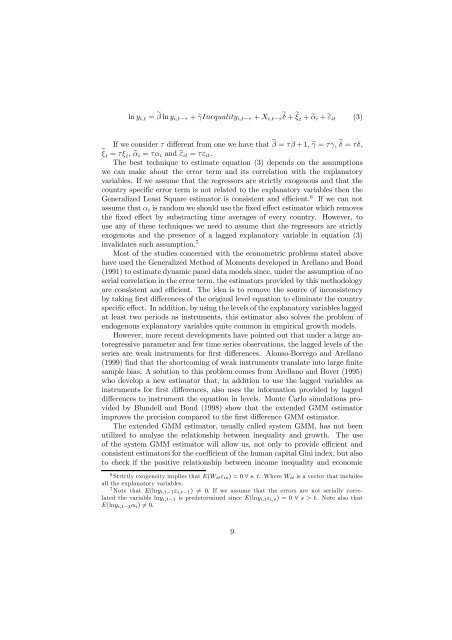Amparo Castelló-Climent, Universidad Carlos III de Madrid ... - Ivie
Create successful ePaper yourself
Turn your PDF publications into a flip-book with our unique Google optimized e-Paper software.
ln y i,t = β ln y i,t−τ + γInequality i,t−τ + X i,t−τ<br />
δ + ξt + α i + ε it (3)<br />
If we consi<strong>de</strong>r τ different from one we have that β = τβ+1, γ = τγ, δ = τδ,<br />
ξt = τξ t , α i = τα i and ε it = τε it .<br />
The best technique to estimate equation (3) <strong>de</strong>pends on the assumptions<br />
we can make about the error term and its correlation with the explanatory<br />
variables. If we assume that the regressors are strictly exogenous and that the<br />
country specific error term is not related to the explanatory variables then the<br />
Generalized Least Square estimator is consistent and efficient. 6 If we can not<br />
assume that α i is random we should use the fixed effect estimator which removes<br />
the fixed effect by substracting time averages of every country. However, to<br />
useanyofthesetechniquesweneedtoassumethattheregressorsarestrictly<br />
exogenous and the presence of a lagged explanatory variable in equation (3)<br />
invalidates such assumption. 7<br />
Most of the studies concerned with the econometric problems stated above<br />
have used the Generalized Method of Moments <strong>de</strong>veloped in Arellano and Bond<br />
(1991) to estimate dynamic panel data mo<strong>de</strong>ls since, un<strong>de</strong>r the assumption of no<br />
serial correlation in the error term, the estimators provi<strong>de</strong>d by this methodology<br />
are consistent and efficient. The i<strong>de</strong>a is to remove the source of inconsistency<br />
by taking first differences of the original level equation to eliminate the country<br />
specificeffect. In addition, by using the levels of the explanatory variables lagged<br />
at least two periods as instruments, this estimator also solves the problem of<br />
endogenous explanatory variables quite common in empirical growth mo<strong>de</strong>ls.<br />
However, more recent <strong>de</strong>velopments have pointed out that un<strong>de</strong>r a large autoregressive<br />
parameter and few time series observations, the lagged levels of the<br />
series are weak instruments for first differences. Alonso-Borrego and Arellano<br />
(1999) find that the shortcoming of weak instruments translate into large finite<br />
sample bias. A solution to this problem comes from Arellano and Bover (1995)<br />
who <strong>de</strong>velop a new estimator that, in addition to use the lagged variables as<br />
instruments for first differences, also uses the information provi<strong>de</strong>d by lagged<br />
differences to instrument the equation in levels. Monte Carlo simulations provi<strong>de</strong>d<br />
by Blun<strong>de</strong>ll and Bond (1998) show that the exten<strong>de</strong>d GMM estimator<br />
improves the precision compared to the first difference GMM estimator.<br />
The exten<strong>de</strong>d GMM estimator, usually called system GMM, has not been<br />
utilized to analyse the relationship between inequality and growth. The use<br />
of the system GMM estimator will allow us, not only to provi<strong>de</strong> efficient and<br />
consistent estimators for the coefficient of the human capital Gini in<strong>de</strong>x, but also<br />
to check if the positive relationship between income inequality and economic<br />
6 Strictly exogeneity implies that E(W it ε is )=0∀ s, t. WhereW it is a vector that inclu<strong>de</strong>s<br />
all the explanatory variables.<br />
7 Note that E(lny i,t−1 ε i,t−1 ) = 0. If we assume that the errors are not serially correlated<br />
the variable lny i,t−1 is pre<strong>de</strong>termined since E(lny i,t ε i,s )=0∀ s>t. Note also that<br />
E(lny i,t−1 α i ) = 0.<br />
9

















